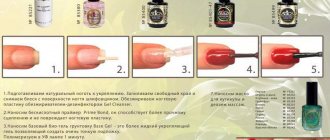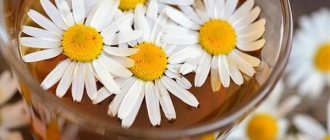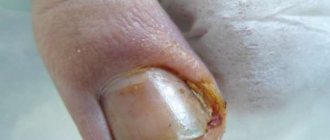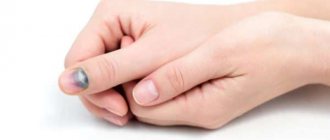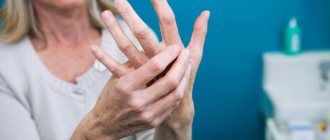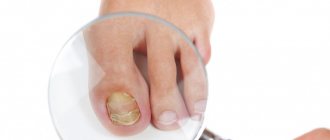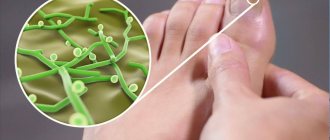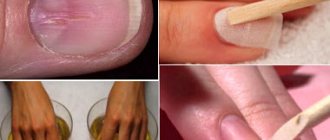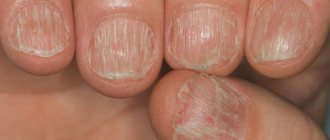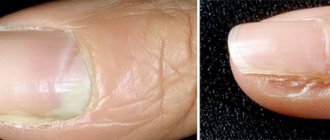Common reasons
Healthy nails are distinguished by a slight shine, smooth surface, and transparency. Their pink color comes from the nail bed, which is visible through the plate.
Common reasons why nails turn yellow on the hands include improper use of decorative varnish, and on the feet - a fungal infection or onychomycosis. But other factors also lead to such changes. Let's take a closer look.
Smoking
Yellowing of the fingertips occurs in heavy smokers, and more often in men. Why do fingernails turn yellow from cigarettes? The fact is that tobacco smoke vapors are absorbed into the top layer of the skin and nail plate, disrupt tissue metabolism, and slow down cell renewal. The longer the smoking period, the more intense the color change.
As a rule, only the nails on the fingers with which a person holds a cigarette turn yellow. Such a cosmetic defect is considered the least of the troubles nicotine brings to our body. Smoking affects the heart, blood vessels, metabolic processes, increases the risk of developing chronic pathologies, and reduces immunity.
Smokers suffer from diseases of the bronchi or lungs, which also affects the color and structure of the nails.
Aging
Why do nails, especially toenails, turn yellow with age? In people over 50 years of age, nail growth and renewal slows down. There are already chronic diseases that lead to impaired blood supply to the lower extremities and nutrition in the area of the nail plate. Elderly people take medications, the list of side effects of which sometimes includes yellowing of the nails.
Thickening, deformation, loss of transparency, and discoloration of the plate in older people are called a special term - senile nail.
Internal illnesses
Chronic pathologies of the liver, gallbladder, and biliary tract are another possible cause of yellowing of nails. Such diseases include chronic inflammatory processes, jaundice, hepatitis, tumors, which lead to an increase in the level of bile pigment bilirubin in the blood. As a result, it accumulates in the subungual space and stains the nail.
Yellow color of nails appears when lymphatic drainage is impaired and blood flow to the extremities is reduced. Retention of lymphatic fluid in the legs, edema, and peripheral circulatory disorders are observed with varicose veins, atherosclerosis, and elephantiasis.
Yellowing of the plate is also caused by pathologies of the endocrine system, including diabetes mellitus, hypothyroidism, and diffuse toxic goiter. With endocrine disorders, metabolic processes in the nail apparatus are disrupted. In addition to yellowing, slow growth of the plate, thickening, crumbling, and delamination are noted.
Decorative coatings
A common reason why women's toenails and fingernails turn yellow is a reaction to decorative varnishes that are applied to the plate without using a base coat or foundation. Yellowing is caused by dark or bright varnishes: red, orange, black, dark blue, dark green. And also cheap or expired.
Why do my fingernails turn yellow after polishing? Onychodischromia under varnish appears as a result of a chemical reaction between the dyes and proteins that make up the plate. If you use nail polish remover with acetone, the chances of yellowing will increase, since the solvent penetrates deeper into the polish.
Why do nails turn yellow under gel polish? This occurs when the gel contains bright pigments, errors in coating, or excessive exposure to a UV lamp.
Not only nails can change color, but also the gel polish or top coat itself. Why does the coating turn yellow? The reason is poor quality composition, violation of the technology for obtaining the product, expiration date or improper care. For example, the color of the coating changes when it comes into contact with household chemicals or coloring compounds.
Nail diseases and injuries
In case of injury, yellow spots form in the area of the free edge of the plate. Such changes cause blows, bruises, pinching. Wearing uncomfortable shoes, shoes with heels higher than 5 cm or narrow toes leads to chronic microtraumas, changes in the shape, structure, and surface of the nail plate.
Among the diseases, onychodyschromia is provoked by:
- Fungal infection. It is 2–3 times more common on the legs of men. Why do nails turn yellow and peel due to fungus? The reason is clouding, thickening of the plate, and accumulation of debris. A nail affected by infection easily crumbles and breaks off;
- Psoriasis. Nails fade, turn yellow, and become brittle. The free edge thickens and peels off. The surface is covered with dotted depressions;
- Onycholysis or detachment of the plate from the bed from the side of the free edge. The separated part of the nail acquires a dull yellow tint and becomes opaque. Onycholysis is caused by trauma, psoriasis, and taking certain medications;
- Onychogryphosis. The nail becomes deformed, becomes very thick, looks like a bird's claw, and becomes dirty gray or yellow-brown. This disorder is a common reason why the toenails of older people thicken and turn yellow;
- Yellow nail syndrome. A rare systemic pathology affecting the fingers and toes. It causes problems with breathing, the lymphatic system, and swelling of the legs. The disease appears accidentally or is inherited.
External factors
The most common reason why fingernails and toenails turn yellow is improper manicure. We are talking about using bright tones of varnishes without applying a protective transparent base. By themselves, the aggressive coloring pigments that make up nail polish can eat deep into the plate. There is no way to remove them from there, either with nail polish remover or polishing.
Yellowness around nails
In addition, these pigments, especially those found in cheap varnishes, have an extremely negative effect on the plate. In addition, long-term wearing of varnishes without a break does not allow the nails to be saturated with oxygen, they lose their elasticity and natural appearance. This is why it is very important to take short breaks between staining. At least 2 - 3 days a month.
Nails turn yellow from polish
Sometimes, even when it is established that the nails are turning yellow from the varnish, the problem cannot be eliminated. Some pigments of the cheapest nail polishes penetrate so deeply into the porous tissue of the nail plate that it is not possible to remove them from there in any way. So, you only have to wait for the growth of a new healthy and unpainted nail.
Yellowness under nails
According to many observations, the use of nail polish remover containing acetone greatly provokes the appearance of yellowness on the nails. This substance severely damages nails, changing the cellular structure of the plate for the worse. The result is yellow spots on the fingernails and toenails in a fairly short period of time.
Yellowness of fingernails
Another significant factor why fingernails turn yellow is exposure to ultraviolet radiation. In this case, yellowness most often appears at the end of summer. It disappears quite quickly, however, in the summer, nails need careful care, since, otherwise, the color may not be restored. Regarding the solarium, the same instructions include the use of a nail protectant and strict adherence to the frequency of visits and the duration of procedures.
Other reasons
In addition to the listed diseases, varnishes, age-related changes, and bad habits, yellowing of nails is caused by:
- taking certain medications (tetracycline, quinolone antibiotics, arsenic, carotene, quinolone);
- malnutrition, lack of vitamins and minerals;
- exposure to ultraviolet radiation or the use of self-tanning, when the product gets on the fingers in the cuticle area;
- genetic characteristics, when everyone in the family has nails with a yellow tint;
- drinking coffee and strong black tea in large quantities;
- contact with detergents, cleaning compounds for cleaning or washing dishes without protecting hands with gloves.
When should you go to a podiatrist?
If the color suddenly begins to change, you cannot ignore the problem. Yellowing of nails can be a temporary cosmetic defect, but can indicate the presence of serious diseases.
To understand the reasons, you need:
- see what decorative varnish or remover you use for manicure or pedicure;
- analyze what shoes you wear;
- remember if there were any nail injuries over the past month;
- remember what new medications you are taking, clarify side effects;
- assess what other changes in well-being have appeared.
If it is difficult to find out and eliminate the causes yourself, go to a podiatrist or dermatologist. The sooner you see a doctor, the faster your nails will recover.
Without special tests, examinations, consultations with specialized specialists, it is impossible to identify serious disorders in the body. We are talking about endocrine disorders, problems with the liver, gall bladder, vascular diseases, and respiratory organs.
The specialist will examine the color, structure of the nail, and changes in shape. Assess the condition of the cuticle, nail folds, bed, skin on the hands and feet.
If necessary, will prescribe:
- general blood analysis;
- blood test for glucose;
- test for thyroid hormones;
- biochemical blood test for liver tests;
- Dopplerography of the vessels of the extremities;
- examination to detect lung diseases.
If the nail plate cracks, crumbles, or smells unpleasant, the doctor will take a sample of the changed nail for microscopic analysis. After all, such symptoms indicate a fungal infection.
What to do?
The treatment regimen depends on the cause. When identifying internal diseases, you need to go to specialized doctors: for diabetes, thyroid dysfunction - to an endocrinologist, for liver diseases - to a gastroenterologist, for problems with blood vessels - to a surgeon.
Varnish painting
If the reason is the varnish, the yellowing will go away on its own as the plate grows back. Fans of bright, saturated colors should apply a base coat under the varnish and use varnishes with a safe composition, without formaldehyde. But it is better to choose light, pastel or nude shades.
Wear the covering for no more than 4 - 5 days in a row, then take a break for 2 - 3 days. During this period, treat the plates with nourishing cream or oils, strengthening and restoring medicinal compounds.
If your nails have turned yellow from polish or smoking, but you urgently need to get them in order, try making a bath with lemon juice or hydrogen peroxide to neutralize the unsightly shade.
Lack of vitamins
If a lack of vitamins and minerals is detected, taking vitamin-mineral complexes or supplements will help improve the condition of your nails. The course of treatment lasts from several weeks to months. Specific medications are prescribed by the doctor.
If you are prone to hypovitaminosis, it is important to review your diet. Add more fruits, vegetables, herbs, cottage cheese, vegetable oils. A lack of vitamins affects not only your nails, but also your overall health.
Onychomycosis
Treatment of fungus consists of hardware cleaning of infected areas, taking local or systemic agents that destroy the pathogen. The nail plate grows slowly, so it lasts from 3 to 12 months. It is necessary for the affected nail to be replaced by a healthy one.
In the future, it is important to prevent re-infection. It is necessary to avoid increased humidity of the feet, prolonged contact of hands with water, and do not wear someone else’s shoes. Wear protective rubber slippers when visiting public showers, swimming pools, saunas, baths, and the beach.
Nail psoriasis
Psoriasis is a chronic pathology, from which it is still impossible to get rid of it forever. Its characteristic feature is red, scaly spots on the surface of the skin. The goals of therapy are to cope with exacerbations, prolong the period of remission, and improve the quality of life of patients. A dermatologist treats the disease.
Depending on the severity of the condition, the following is prescribed:
- agents that relieve inflammation;
- retinoids that suppress excess cell growth;
- immunosuppressants;
- vitamins;
- drugs that improve the condition of the skin and nails.
To prevent exacerbations of psoriasis, proper care is important, as well as the elimination of provoking factors. The latter include injury, stress, infection, exposure to the sun, cold or dry air.
Treatment Options for Yellow Nails
Trying to determine the causes of yellowing on your own is not the surest or easiest way. A visit to the doctor and tests will show more clearly what needs to be worked with.
So, you have consulted with a specialist, localized the causes of yellowing - what next?
Of course, the coloring is caused by internal factors - it is necessary to treat the disease directly. It is likely that at the same time as your recovery, you will regain your good appearance.
If there is a lack of any microelements and nutrients, you need to balance the diet, make sure that the body receives all the necessary minerals, vitamins, as well as proteins, calcium, and fats.
The fungus should be treated with medications prescribed by a doctor, these could be ointments, baths, or a special hygiene regimen.
If the interesting coloring is associated with external factors, eliminate as quickly as possible what is so detrimental to your appearance. If it’s smoking, you should give up in any case: firstly, if your experience as a smoker is still too long, you can hope for the return of the original color, and secondly, it will definitely be healthier than continuing to smoke.
Is it possible to whiten yellow nails and how to do it at home?
Avoid decorative varnishes for a while – your nails need to “breathe”.
At home, they will help you cope with the unaesthetic color of the bath - with sea salt, lemon juice, soda, tea tree oil, lavender oil, ylang-ylang oil, vinegar. They will not only eliminate the yellow tint, but also strengthen the nail plates.
Glycerin and even regular toothpaste will also help with whitening.
Baths with soda, salt, vinegar and lemon juice should be prepared in the proportion of 1 tsp of active substance per 200-300 ml of water.
Essential oils should be diluted with base oils and taken in an amount of 2-3 drops, rubbing into the nails.
Combine glycerin and hydrogen peroxide in a mixture of 1 to 1 and apply to nails for two weeks to a month.
To see qualitative changes, you should use home methods for quite a long time, you will have to be patient.
Human health is the key not only to good health, but also to work productivity and a good image. The body's signals about failures and malfunctions can be deciphered if you are attentive to yourself. A problem detected in time is already half solved, so if your hands begin to look strange, do not refuse them attention - perhaps they are the first to warn you of impending problems.
